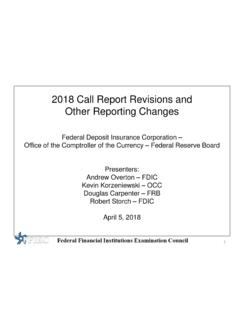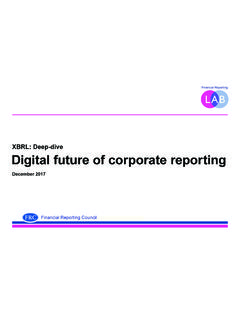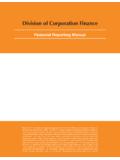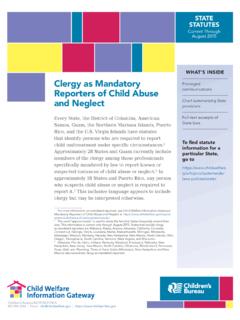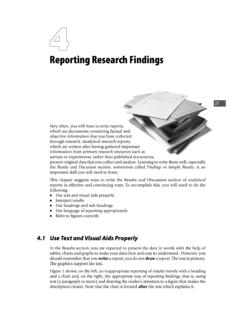Transcription of Current Practices in Occupational Health & Safety ...
1 Current Practices in Occupational Health & Safety Sustainability reporting A report From the Center for Safety and Health Sustainability February 2013. Ensuring the Safety , Health , and sustainability of the global workplace. About This report The Center for Safety and Health Sustainability would like to thank Kathy A. Seabrook, president of Global Solutions Inc., for providing financial support for this project. The Center would also like to thank ABB Inc., BP, Aon Corporation, Karl and Elizabeth Jacobson, and Rixio Medina for their support. This research was compiled by Center for Safety and Health Sustainability staff liaisons Dennis Hudson and Laura Clements with the support of Andres Olavi Aya and Brenda Kay Zylstra. The Center for Safety and Health Sustainability (CSHS), established in 2010, is a 501(c)(3) nonprofit organization committed to advancing the Safety , Health , and sustainability of the global workplace. CSHS. engages Safety and Health partners around the world to work toward establishing minimum standards that help reduce workplace injuries and ill Health .
2 A collaborative effort founded by American Society of Safety Engineers, American Industrial Hygiene Association and Institution of Occupational Safety and Health , CSHS represents more than 85,000 workplace Safety and Health professionals worldwide. 2. Contents 4 EXECUTIVE SUMMARY. Key Findings 6 INTRODUCTION. Methodology 8 GLOBAL reporting INITIATIVE (GRI) Occupational Health AND Safety INDICATORS. LA6: Percentage of total workforce represented in formal joint management . worker Health and Safety committees that help monitor and advise on Occupational Health and Safety programs LA7: Rates of injury, Occupational diseases, lost days and absenteeism, and total number of work-related fatalities, by region and by gender LA8: Education, training, counseling, prevention and risk control programs in place to assist workforce members, their families or community members regarding serious diseases LA9: Health and Safety topics covered in formal agreements with trade unions 15 CENTER FOR Safety AND Health SUSTAINABILITY PROPOSED.
3 Occupational Health AND Safety INDICATORS F OR GRI FRAMEWORK. Lost-time injury and illness incidence rate, lost-time injury and illness severity rate, and number of fatalities (all workers 5-year period). Lost-time injury and illness incidence rate, lost-time injury and illness severity rate, and number of fatalities (all contractors 5-year period). Percentage of owned or leased work locations that have implemented an Occupational Health and Safety management system that meets recognized standards Percentage of owned or leased work locations that have had their occupa- tional Health and Safety management systems audited by an independent third party Percentage of direct or first-tier suppliers' facilities in developing countries that were audited for compliance with Health and Safety standards 19 CONCLUSION. Future Research Recommendations 3. Executive Summary T. he report that follows aims to provide a GRI indicators are explicitly addressed or not, as well snapshot of actual Occupational Health and as those recommended by the Center for Safety and Safety (OHS) sustainability reporting by analyz- Health Sustainability ( the Center ).
4 Ing reports from organizations currently considered The study involved the collection of corporate social sustainable. The report presents an analysis of the responsibility, sustainability and annual reports from extent to which organizations report OHS sustain- the Corporate Knights' 2011 Global 100 Most Sustain- ability information, the degree to which information able Corporations in the World. Raw data on metrics reported provides insight into actual OHS perfor- pertaining to OHS were collected, analyzed and mance and the extent to which information reported organized first with regard to GRI's LA6-9 indica- lends itself to being compared across organizations. tors, and second with regard to those of the Center. It is also intended to help the Global reporting Included in each section are aggregate summaries on Initiative (GRI) improve OHS sustainability indicators how well the group responds to each indicator. The in its upcoming version G4 and future iterations.
5 The report concludes with recommendations for optimiz- report achieves this goal by analyzing these organiza- ing the LA GRI indicators for the purposes of encour- tions' attention to indicators currently recommended aging comprehensive, meaningful reporting . in GRI's version Labor Aspects (LA) 6-9 (which deal with Occupational Health and Safety ), whether Key Findings The sustainability reports collected from the Global 100 reflect: High variability in terms and definitions used to report OHS, making it difficult to use reports to compare OHS performance across organizations, for example: Terms related to rates of injury, report -worthy injury or incident, lost day accidents and absenteeism.. Formulas used to determine injury rates, Occupational disease rates, lost day rates (both workers/employees and contractors) and absentee rates. Very low (< 10 corporations) reporting with regard to GRI indicator: LA6 overall LA7's request for Occupational disease rate/number of cases and contractor lost day rate LA8 overall LA9's request for percentage of workers covered by collective bargaining agreements.
6 No organization provided a full response to GRI-recommended indicators. The highest relative level of reporting for commonly prescribed metrics on worker/employee inju- ry rates. Very few, however, used the formula for calculating injury rates recommended by GRI. Compared to that for workers/employees, very low reporting with regard to contract temporary workers' lost day rate and injury rate. A high amount of fatalities (10 or more) reported by five organizations. One organization reporting 49 fatalities in a year and another reported 81 fatalities over a 3-year period (2010-12). No organization reported on fatal Occupational diseases. Roughly a third of organizations reported on major topics recommended by the Center, reporting information that complies generally with Practices endorsed by the OHS community. 4. Figure 1. Percentage of organizations reporting Figure 2. Percentage of organizations on OHS topics covered in GRI reporting on OHS topics recommended by CSHS.
7 0% 20% 40% 60% 80% 0% 10% 20% 30% 40%. LA6: Percentage of total workforce represented in formal joint management-worker Health and Safety committees Management LA7: Injury Rate, Employees Systems LA7: Injury Rate, Contractors LA7: Occupational Disease Rate Direct or First-Tier Supply Chain Audit LA7: Rates by Gender LA7: Lost Days, Employees Independent Audit LA7: Lost Days, Contractors of OHS Management System LA7: Absenteeism Rate LA7: Work-Related Fatalities, Employees LA7: Work-Related Fatalities, Contractors Corporations Supplying Information on Topic LA8: Education, Training, Counseling, Prevention and Risk Control Programs Regarding Serious Diseases LA9: Health and Safety Topics Covered in Formal Agreement with Trade Unions Corporations Supplying Information on Topic Corporations Providing Information Conforming With GRI Format Corporate transparency is not achieved simply by disclosing information. The information disclosed must also be meaningful.
8 Recommendations The Center recommends that GRI and other sustainability reporting frameworks better promote the impor- tance of OHS as a major indicator of an organization's overall sustainability and adopt OHS performance indicators meeting the following criteria: Well-defined and standardized terms and definitions that allow for accurately evaluating an organization's performance across different sectors and geographies. Standardized data collection methodology that allows stakeholders to easily compare Safety performance across and among organizations. The reporting of leading indicators, allowing stakeholders insight into whether corporations are taking meaningful actions to improve OHS performance. Information reported over multiple years ( , 5) enabling internal and external stakeholders to use the information to gauge improvement and compare performance to other organizations over time. An extended scope of coverage that includes OHS reporting for contingent workers (including temporary contract and subcontractor workers) as well as workers in the supply chain growing and highly vulnerable segments of the global workforce frequently left out of OHS reports.
9 Evidence suggests that organizations that internalize proactive OHS tend to be more highly sustainable overall compared to those that do not. Organizations identified by the Global 100, however, overwhelmingly do not use OHS indicators compliant with GRI recommendations, and OHS reporting as a whole. The information disclosed frequently lacks meaning with regard to providing a realistic perspective on OHS performance. Corporate transparency is not achieved simply by disclosing information. The information disclosed must also be To serve stakeholders' desire to evaluate corporate performance, the information an organization discloses must be provided in a format that is readily understood, analyzed and utilized. 1. In a recent analysis of the reporting Practices of 94 Canadian corporations, 585 different indicators were identified, with 55% of them being used only once. Searcy, Cory, and Roca, Laurence Clement, reporting on Corporate Sustainability Performance, The Conference Board, October 2012.
10 5. Introduction I This report seeks to expose n 2011, the Global reporting Initiative (GRI), a network-based organization that developed the world's most widely used sustainability report - gaps in overall OHS. ing framework, announced plans to develop version G4, the fourth generation of its guidelines. Now in reporting and determine development, G4 is set to be released in May 2013. the practicality and utility The GRI sustainability framework provides a means for organizations to measure and report of the Current GRI. economic, environmental, and social performance OHS-related indicators.. by way of a set of principles and indicators.. To develop G4, GRI is using an international multi- stakeholder consultation process involving open dents offered ideas for indicators, with a large public comment periods, working groups from majority offering the same five Occupation a broad array of stakeholder groups, and a set of (sic) Health and Safety approval procedures designed to ensure a consen- In response to the interest expressed in OHS during sus-based product that reflects the broadest the consultation process, GRI announced plans to stakeholder input possible.

